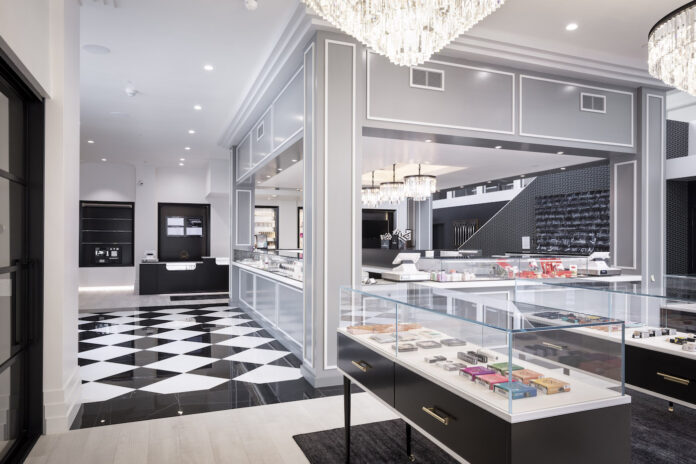It used to be so easy to buy cannabis: Call your source, or maybe drop in on a neighbor. Then head shops became a thing, cementing the laid-back, low-pressure, artsy environment that so fully embodies the stoner stereotype. The mellow ideal worked for a while, but maturing legal markets have changed the vibe. Excitement is the new buzzword in retail as the plant moves ever closer to becoming just another consumer commodity. Consumers increasingly look to in-store shopping to provide community, information, and entertainment, and dispensaries are responding with album-release parties, presentations about the plant’s medicinal properties, trivia contests, and immersive environments.
This is experiential retail, a long-established concept in older sectors. Traditional retailers have incorporated special events and ancillary activities to build excitement since at least 1861, when children began sitting on Santa’s lap in Macy’s iconic New York store. In 1931, legendary toy emporium FAO Schwarz installed giant slides to provide kids and their parents with an adventure more daring than stairs. Nike drew skeptical curiosity in 2016 when it built a half court in its flagship store, where sneakers sales benefitted as dribbling customers test-drove the latest styles and visiting athletes drew crowds.
Experiential installations are not a fad, but rather the past and future of retail. Far from existing as mere eye-catching gimmicks, tactility and experience have become a product at least as important as the merchandise. Individual features may phase in and out of style, but experts say experiential retail is here to stay as a vital part of every retail category.
The cannabis industry may be late to the party, but it’s down to clown. The competition for customers increasingly is waged with concerts, baking demonstrations, and Instagrammable moments.
Age-appropriate
Baby Boomers discovered the pleasures and benefits of cannabis in the late 1960s, when using marijuana generally meant covertly smoking joints and bongs. Today, the aging generation is discovering edibles to deal with afflictions like insomnia and pain. Boomers research products on the internet and have been conditioned by decades of traditional retail engagement to shop on price.
Millennials, who account for about 25 percent of the population and annually exercise collective buying power of more than $1 trillion, currently compose the largest market for cannabis products. Now in their mid-twenties to early forties, these customers supplement flower with edibles and vapes, and polls consistently find they prefer to spend their money on experiences rather than things. According to Millennial Marketing, 69 percent of millennials crave adventure in their daily lives. HubSpot noted, “Millennials tend to crave the experience of shopping more than the purchase.”
But it’s Generation Z—the so-called cannabis natives—who are carrying the biggest torch. Only the oldest are of age to consume legally, but their tastes for flower, vapes, and concentrates are well established. Zoomers, few of whom have reached age twenty-one, do not subscribe to the same stigma about the plant as earlier generations. They were born after California legalized medical marijuana, and two-thirds of those who are old enough consume weed more frequently than alcohol. Seventy-seven percent of this powerhouse-in-waiting prefer to buy in a store or at least visit a physical location to check out products, but retailers still have to capture their interest.
Stores investing in retail entertainment have plenty of mainstream models from which to draw ideas. Cosmetics titan Sephora is slicing customers from traditional outlets such as department store counters (with their hovering salespeople) and drug stores that sell makeup sealed in try-your-luck packaging. Sephora puts hundreds of products out where customers can try them on and wipe them off one by one until they find the perfect shade. The stores are exciting and interactive, encouraging impulse purchases that buoy the bottom line. “Some people spend hours here,” said a Sephora saleswoman in suburban New York. “And you better believe no one buys blue shadow in a department store.”
The list goes on. Bookstores install coffee shops, tuck reading nooks into corners, and host author appearances; Amazon does not. Apple offers in-store classes and encourages shoppers to fiddle with the newest iPhones. Doesn’t that sound like more fun than Best Buy?
The closest comparison to cannabis is wine. Both products attract consumers with experience levels that range from curious to connoisseur. Budtenders, like sommeliers, must help all of them make sense of myriad strains and blends, origins and appellations, terpenes and nose, potency and brix. But elevated wine shops offer something dispensaries cannot: tastings. As Costco potently illustrated, sampling the merch is one of the most immediate and purchase-compelling shopping experiences.
In place of product sampling, cannabis retail has turned to social media influence peddling. The internet-famous always need something to stand in front of, and there’s nothing better than a trippy graphic wallpaper to attract Instagrammers or a wall of flower that really pops on TikTok. “The Instagrammable flower wall is the least you can do—and I mean the very least,” said Trevor Lewis, chief revenue officer for InStore Design Display, a century-old firm in Kansas City, Missouri, that refocused its retail work on cannabis. “That’s table stakes now.”
But despite constraints, retailers are creating storylines and building experiences that resonate with customers.
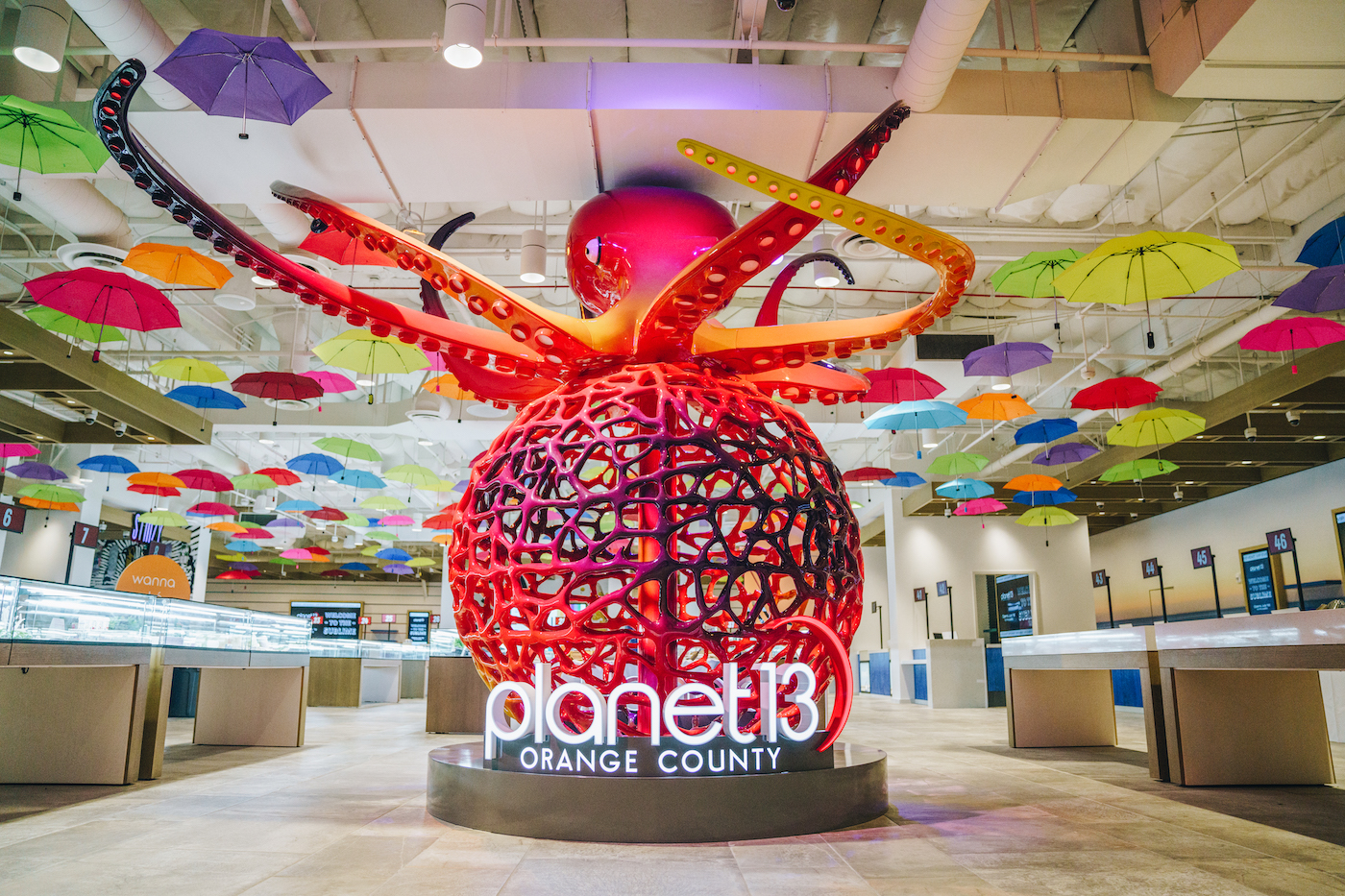
The sideshow
No dispensary is more committed to experiential retail than Planet 13, the Las Vegas superstore that has built wonder in every direction. The moment customers walk in, a sophisticated apparition of a placid pond appears to splash beneath their footsteps. LED fish scatter when real-world humans get too close. Magical spheres change color as they float overhead. Employees calmly pour and release enormous trays of gummies behind a glass wall, while robotic helpers take a break from moving pallets for one-minute lightsaber jousting matches.
The experience is big, bright, and immersive.

Larry Scheffler, a former city council member in the Vegas suburb of Henderson, and former Henderson Mayor Robert Groesbeck hatched the concept in 1993 when a community board meeting touched on the legalization of medicinal marijuana. Scheffler remembers Groesbeck telling him, “It’s the last of the sins to be legalized. We’ve got to get on board.”
The longtime business partners started on the medical side of the industry in 2014 and planned for the day recreational sales would become legal. But Planet 13, which opened in November 2018, would not be modeled on mainstream retail. “We are a mile from the Strip,” said Scheffler, explaining the store’s Vegas DNA. “We were influenced by the hotels, the Bellagio’s fountains, and the volcano at the Mirage.”
Planet 13 Holdings went public on the over-the-counter markets in 2018 when it completed a reverse merger with a defunct Canadian mining company. With $60 million in cash and no debt on the balance sheet, the co-chief executive officers doubled down on their project’s attractions. Scheffler is giddy about Trece (Spanish for thirteen), the year-old restaurant where diners can spice up their meals with infused butters, salad dressings, and sauces.
In addition, the twenty-four-hour dispensary recently opened a 53,000-square-foot nightclub and soon will host a cannabis museum. And, of course, there is a wedding chapel. This is Vegas, after all.
At first, most customers were locals. Tourists rapidly embraced the wildly entertaining spot, though … until the coronavirus pandemic locked down Sin City. As fear of the virus faded and tourists returned, Planet 13 became yet another must-make pilgrimage on comprehensive Vegas itineraries. Seemingly ceaseless waves of out-of-towners found their way off the Strip to visit the store they’d seen on Instagram. Today, 90 percent of the superstore’s customers are tourists, according to the company’s pitch book. Vacationers generated nearly all the store’s 2021 revenue, which topped $120 million.
That cash flow fueled a rapid expansion phase for the parent company, which intends to expand to fifteen stores in Florida and partner with a social-equity licensee in Chicago over the next two years, among other plans.
Planet 13 does not judge. If customers want to take a few hits off their purchase in the parking lot and come back for the GPS-guided flying spheres, skittish fishes, and mesmerizing mass-production process, that’s just fine.
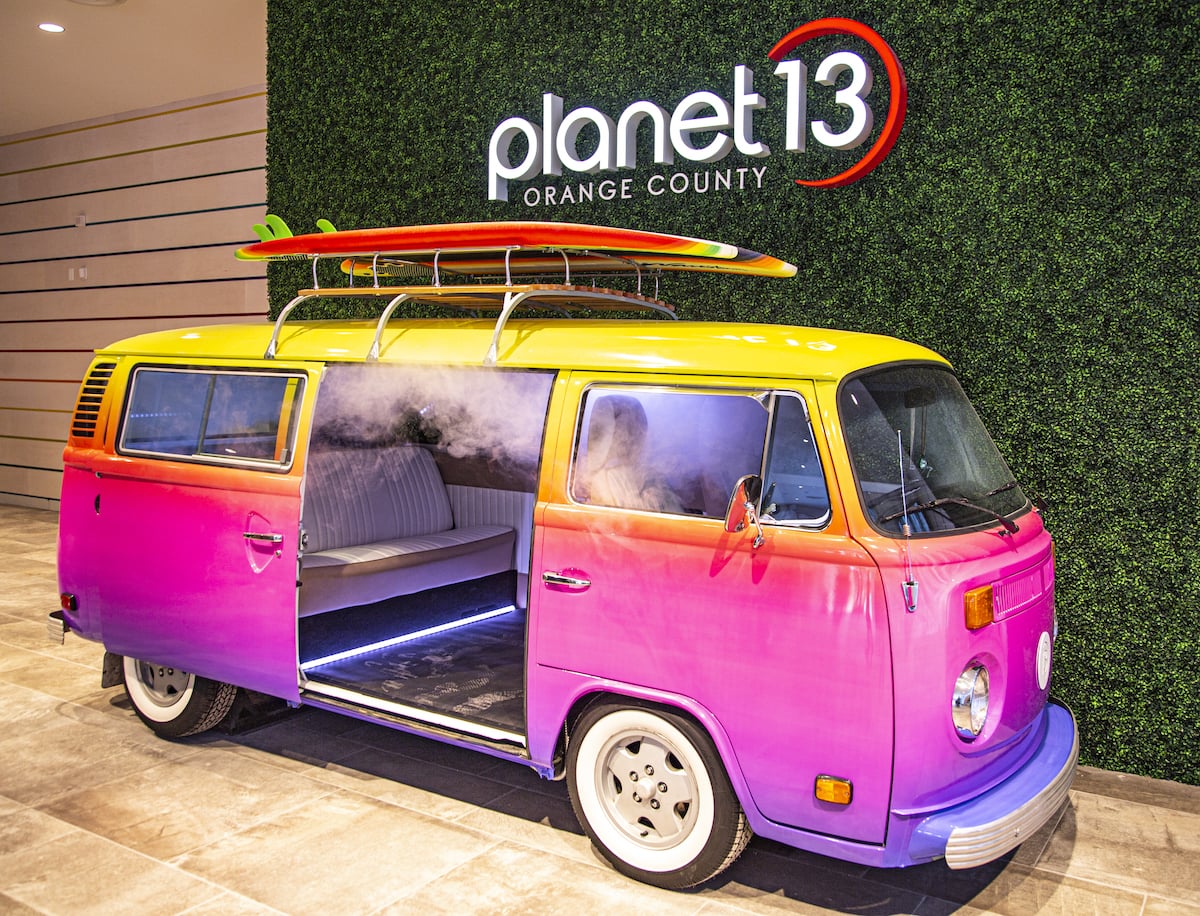
Is any entertainment idea too far out to be explored?
“Well, we did buy a brothel, the Bikini Brothel, several years ago,” said Scheffler. “We were pimps for about fourteen minutes.” He quickly clarified the entertainment didn’t interest the company anywhere near as much as the eighty-acre property the brothel occupied, which was already outfitted with a generator, water system, and even an airfield capable of accommodating a 727. If Scheffler has decided what he to do with the property, he’s not telling.

“You always have to evolve,” said David Farris, Planet 13’s vice president of sales and marketing. “It’s not like you find the right algorithm. Markets mature. People will not keep flooding to your door just because it’s cannabis.”
Farris’s favorite Planet 13 experience is surprisingly old-fashioned. A VW bus—universally recognized as the original smoke den on wheels—serves as the backdrop for countless group photos of teams and tourists. He pointed out the groups plaster social media with the images, where they are seen by millions. The fifty-year-old van occasionally goes viral, bringing the retailer a Vegas-sized global marketing boost.
Atmosphere as adventure
Single stores and local chains can’t even attempt to compete with multistate operators on price, promotions, or variety of goods, but people will shop where they are comfortable. Some folks feel good supporting local businesses, while others seek out companies owned by women or minorities. Right now, sales are largely deal-driven, but as competition becomes fiercer, stores must set themselves apart in other ways as well. Some dispensaries have determined the best way to differentiate is to assimilate.
In cannabis, as in few other retail sectors, entertainment and experience can be interpreted broadly. How about time travel? In south Los Angeles, one dispensary aspires to recreate a speakeasy from the Harlem Renaissance. The look is 1930s black-and-gold flocked wallpaper—an homage to the tea pads and salons that dotted Harlem in the 1920s and ’30s, where Black performers, writers, activists, and others discussed social issues over cocktails, joints, and jazz—but the vibe is contemporary, emphasizing community and heritage.
Josephine & Billie’s, named for Jazz-era icons Josephine Baker and Billie Holiday, was inspired by the women and the era they have come to represent. “Josephine and Billie were Black women who performed what they wanted, lived by their own rules, and used their art to fight against injustice,” said cofounder and Chief Executive Officer Whitney Beatty, whose dispensary was one of the first projects staked by Jay-Z’s cannabis enterprise, The Parent Company. “Their strength made White men uncomfortable. They were prosecuted for cannabis use by racist, misogynistic officials.”

The dispensary, with its mission to encourage pride and well-being, has been a well-received addition to a strip mall in the predominantly Black and brown neighborhood Beatty wants to serve. All are welcome, but the shop makes no secret of reaching out especially to women of color.
“When you’ve been raised in a community constantly hit by the war on drugs, the older population is particularly terrified by taking cannabis. It helps when we explain the history,” Beatty said. “This is so important, because these women, particularly the older ones, have so much to gain from cannabis.”
But lingering stigma isn’t the only challenge retailers face, Beatty admitted. “It’s 2022, and you can’t get me out of the car at Target,” she said. “How do we get people to come to [a dispensary] on a weekly basis?”
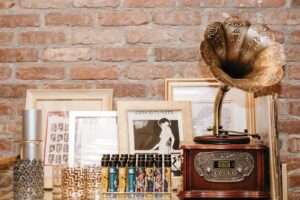
Creating a community within a community is one potential solution, and she’s approaching that goal from several angles. Books about history and social justice are displayed throughout Josephine & Billie’s, meant for customers to leaf through while relaxing in the lounge at the back. That room is accessible only with a secret passphrase: “Billie sent me.” Beatty hopes the spot will become a neighborhood hangout, and she hosts a variety of events to bring in the community: board-game nights, record-release parties, pilates classes, and presentations about subjects such as how cannabis can enrich one’s sex life. Eventually, she plans to turn the space into a consumption zone.
Right now, she is most excited about the monthly “Tea and Terpenes” gatherings during which she and her staff explain the nuances of cannabis over fine china. Unlike most dispensaries, Josephine & Billie’s is laid out in five zones organized by effect rather than brand or product. “We think a lot of shoppers don’t get much information beyond, you know, is it sativa,” Beatty said. “We are making cannabis less frightening to these customers.”
Valentia Valentine is doing similar work for a very different community: Carmel-by-the-Sea, California, a monied enclave of 3,789 residents with a median age of 65 and an average net worth of about $6 million. She opened Synchronicity Holistic in 2019 to demystify and rehabilitate the cannabis plant for a clientele more likely to associate it with teenage delinquency than the medicine Valentine sells. The dispensary’s dramatic Art Deco rooms are plush and tasteful, carefully styled to appeal to retired executives, lunching ladies, and aging heirs. Concentrates are behind a bar, and everything else is displayed like jewelry in heavy cases and along glass shelves.
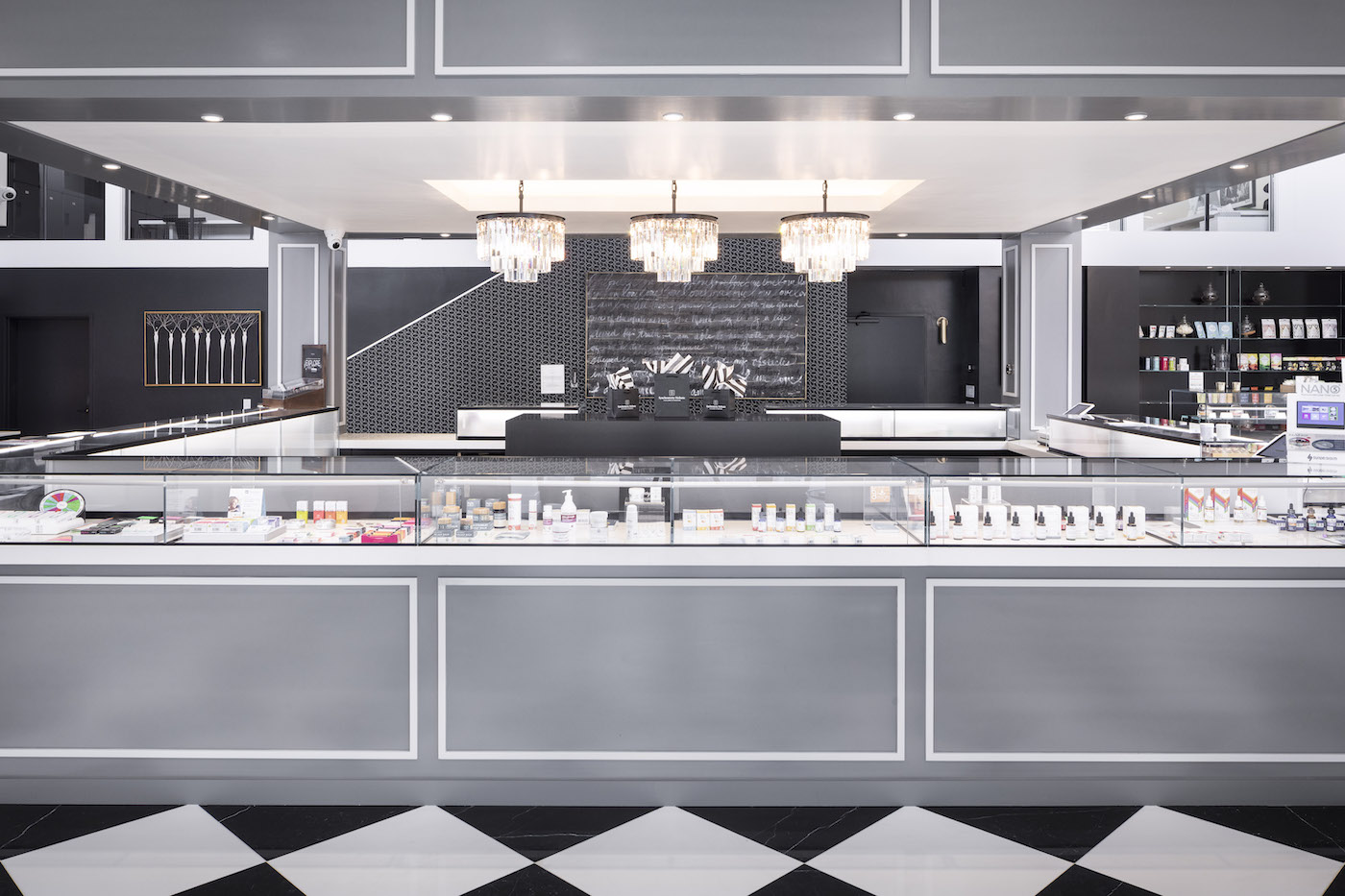
“We are destigmatizing [cannabis] one customer at a time,” said Valentine, who credits the plant with helping her manage the effects of multiple sclerosis. She and the rest of the Synchronicity Holistic team, which includes registered nurses and an in-house pharmacist, help consumers to feel less anxious, sleep better, and drink less. “We teach people how to self-medicate so they don’t fall asleep and can relax with a book,” she said.
Armature and underpinnings
Successful cannabis shops need more than shelves and budtenders. Without a sturdy armature, even the most exciting dispensaries will not stand. Every shopper wants to move seamlessly through the funnel while feeling both familiar with the process and intrigued by innovation. No matter the merchandise, shoppers want to be entertained, find the goods they’re looking for, and believe all their questions and concerns will be addressed.
What makes the process different for cannabis? Regulations—a morass of arcane rules that vary from state to state and sometimes city block to city block. “You’ve got to know the rules,” said InStore Design Display’s Lewis. “Not all dispensaries do.”
The waiting room is a unique, sometimes static space with walls that often cry out for marketing and education. Strict inventory requirements in some places mean no product—not even a CBD air freshener—can be placed on the selling floor. Empty packages and elaborate collateral material must suffice.
The most significant difference between “regular stores” and dispensaries is the need for product information so clear and copious it would amount to overkill in any other environment. But don’t use a blackboard. The aesthetics are important. Millennials and Gen Z are comfortable with computers and video monitors. The displays are the most common point-of-sale tools, according to Lewis, “but they are the most complex to execute.
“It’s challenging when you think about the overall experience,” he said. “State-to-state regulations force you to design your facility and store to accommodate your ordinances, and regulations dictate layout, but as with any [other] retailer, your store should reinforce your digital commerce and connect with your brand.”
If they haven’t done so already, now would be a good time for retailers to merge their online presence with their physical stores. A multiplatform sales presence has been important for years but, thanks to the pandemic, the market has reached a point where integrated digital operations are no longer optional.
It’s fair to say consumer curiosity is stronger today than ever before, in part because it’s so easy to research the plant online. “When they buy online, people are used to having information at their fingertips,” said Jen Dye, founder and chief operating officer at The Peak Beyond, which developed and manufactures digital shopping stations. “We are bringing that familiar process into brick and mortar. Beginners, recreational and medical consumers, and connoisseurs—they all have different questions. The stations let people explore according to their curiosity.”
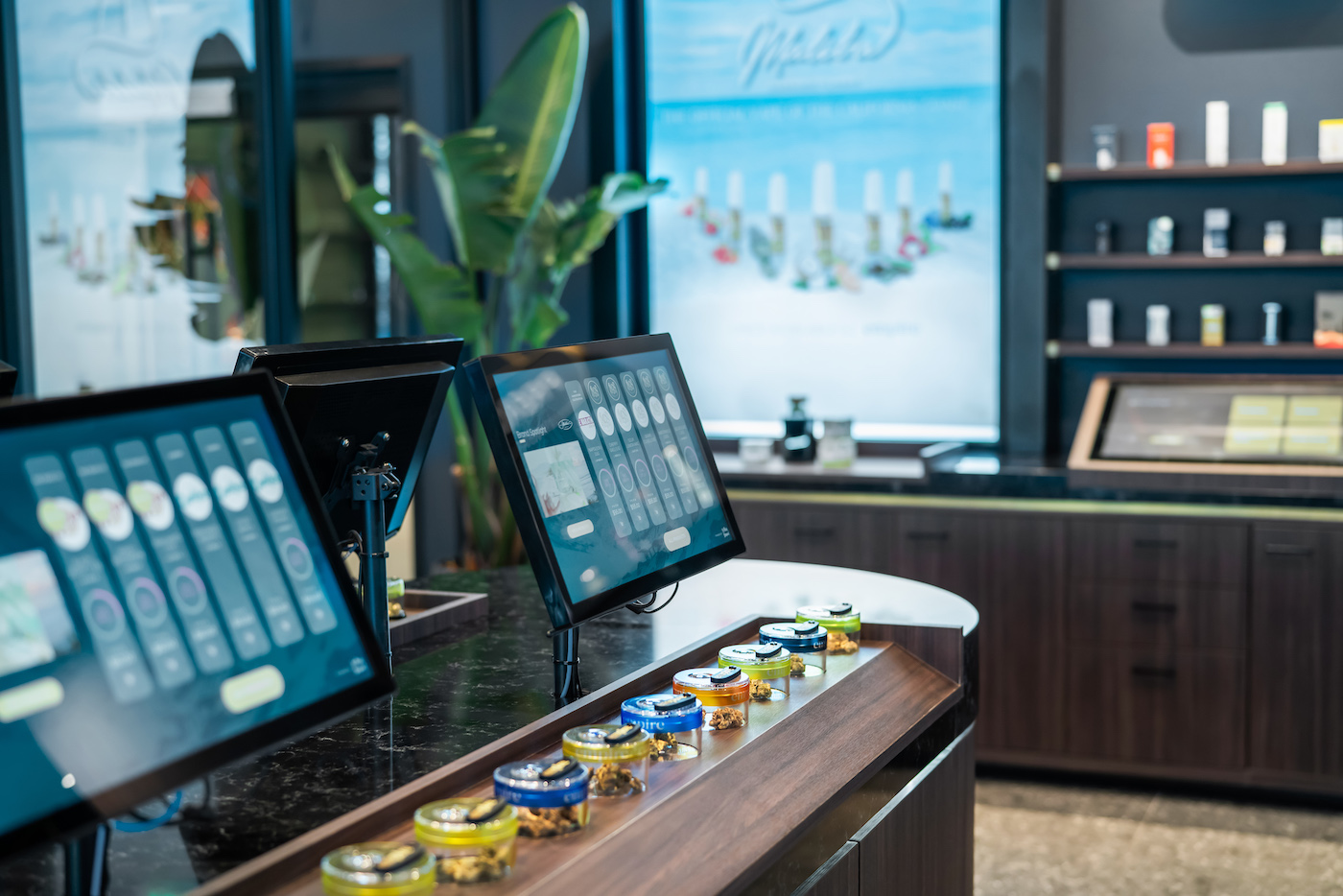
The stations—and self-service kiosks developed by companies like Frank Mayer, greenbox, and Grasshopper—add a high-tech edge some consumers find appealing while freeing up dispensaries’ human resources for other tasks. The machines take orders and collect payment, which speeds the customer out the door. But do they improve the overall experience in a system that, since the dawn of the industry, has relied on budtenders for enthusiasm, instinct, and advice?
The answer is “yes” and “no,” depending on which consumer segment is asked. A knowledgeable human ally can be invaluable when negotiating a thicket of edibles, concentrates, and flower. For the curious, new-ish or casual users, or technology-averse, budtender attention is imperative. But for some customers, human interaction creates unnecessary friction. Tech-savvy and hurried shoppers often don’t care for budtenders’ unavoidable subjectivity, which can seem as useful as asking a waiter what restaurant menu items look best tonight. Others simply want to be left alone to browse in peaceful solitude like they would in any other retail establishment. Connoisseurs who care deeply about the plant may consider the knowledge held by even the most well-informed budtenders inferior to detailed information provided by cultivators, extractors, and brands. For the latter groups, interactive technology is a must. Combining digital and analog options will serve most dispensaries well.
Diverse product selections and competitive prices always will be important to consumers, but as competition increases and stigma fades, cannabis shopping habits will become ever more similar to those in traditional retail sectors. Once federal prohibition ends, the plant alone will cease to be the primary draw, leaving retailers to devise creative ways to attract new customers and maintain the attention of those they already have. Whether they build amusement-park-like atmospheres, provide white-glove service, introduce robotic assistants, or innovate in some other way, operators who differentiate themselves will enjoy a significant advantage.







